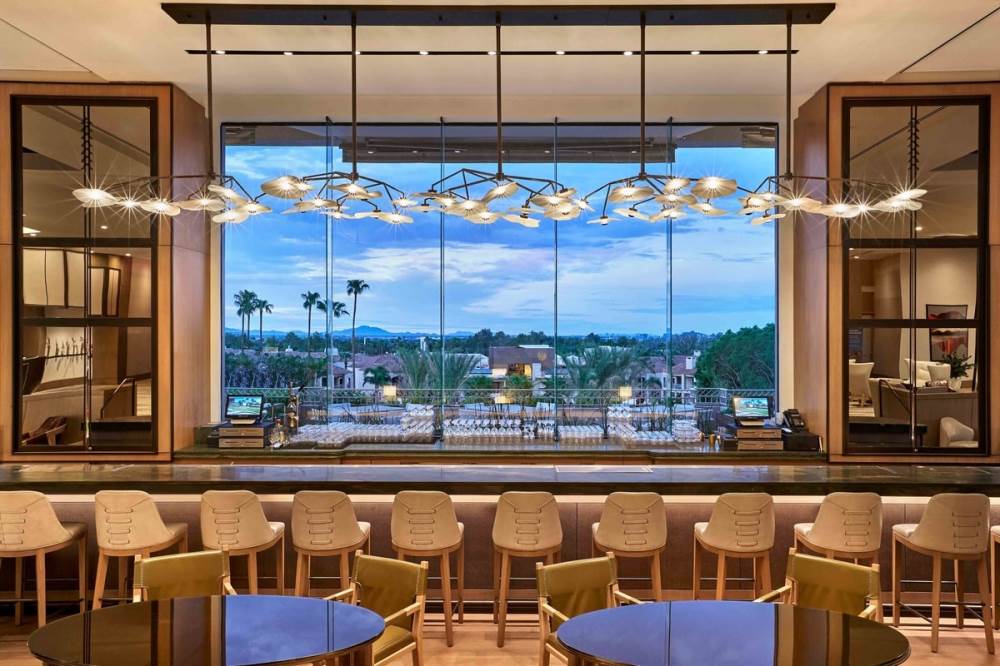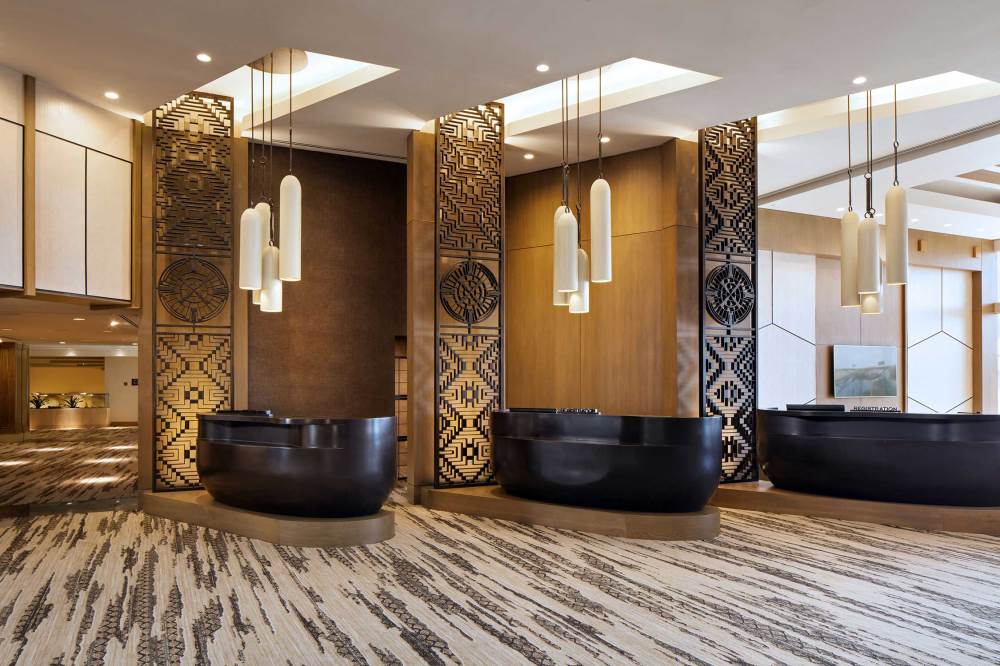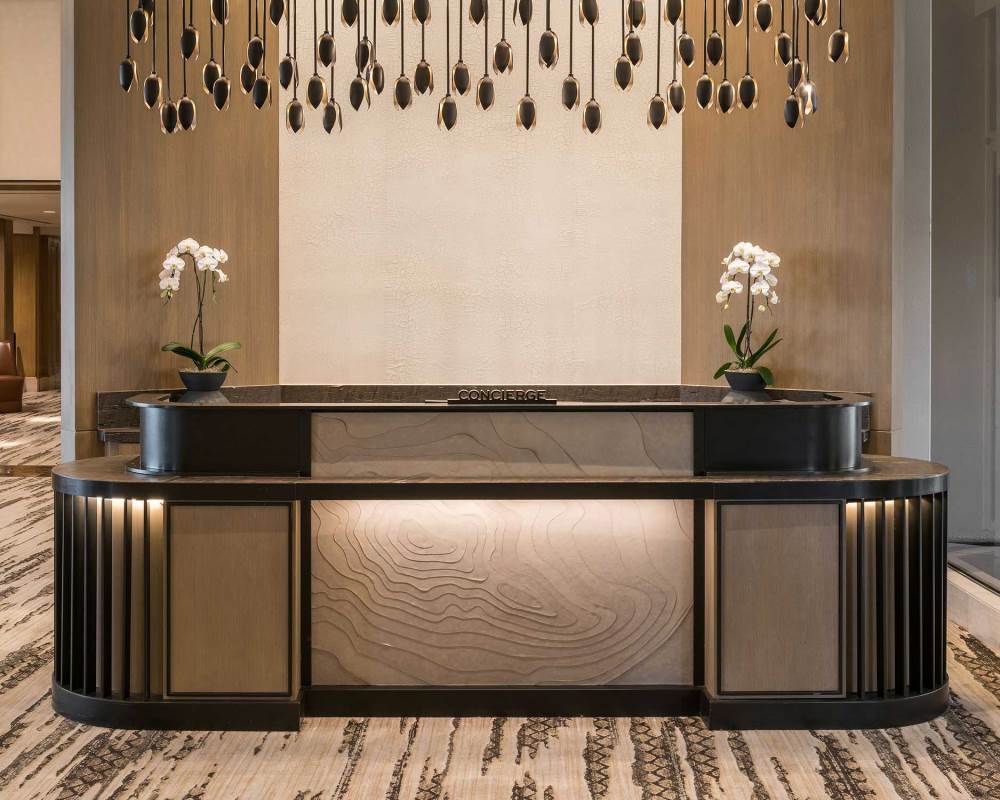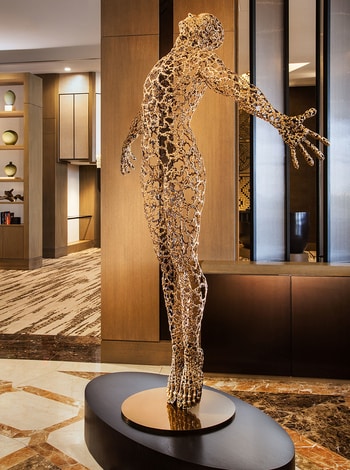Local touches are popping up everywhere in hotel design. This can include the obvious like murals and artwork representing the location of the hotel; to the more subtle inclusion of local craft beer, spirits and food in a bar or restaurant; or even the nuanced or abstract design waiting to be discovered in more upscale hotels.
Parker-Torres: The Phoenician

With the redesigned Phoenician Resort, the team at Parker-Torres Design wanted to bring the outside in. One way they did that was through the view of the Paradise Valley from the lobby bar. Credit: Garrett Rowland Photography
Travelers looking for a deeper experience or connection to their destination are expecting it in all aspects, including hospitality. Hotels are now acting as a “community portal,” according to research by travel brand Skift.
While the trend for localization in hospitality has been around for years, it’s only reached the mainstream in the past few years, as hotel design or renovations were finishing and opening to the public.
Hotel guests travel for local experiences, and owners and brands really understand that, notes Allison Barry, principal at Kevin Barry Fine Art (KBFA). “Bringing in food, design, amenities and an art program that genuinely echo the vibe of the city is important for transforming guests from visitors to locals.”
Without that localization, travelers could walk into a hotel anywhere in the country and it will look the same, no matter the location.
“People like the local experience, and travel because of the experience,” says Miriam Torres, co-founder of Parker-Torres Design. “Brands want to bring the local feel and aesthetic into the industry so people can travel and know where they are, even if they are in the hotel all day long.”
Redesigned Phoenician Resort Brings the Outside In
Torres, along with her partner Barbara Parker, recently completed work at the Phoenician Resort in Scottsdale, AZ, renovating the on-site lobby, spa and two food and beverage locations. In the renovation, every piece in the lobby is about Arizona, Torres notes.
When working with a luxury collection property like the Phoenician, the design is very subtle, Parker explains. Their firm creates the look through an extensive concept backed by research. From there, they find elements to bring into the design.
Parker-Torres: The Phoenician Lobbypods

The Phoenician Resort in Scottsdale, AZ, includes a recent renovation of the on-site lobby, spa and two food and beverage locations. In the renovation, every piece in the lobby is about Arizona, down to the carpet that features a subtle snakeskin pattern. Credit: Mark Silverstein Photography
“In the Phoenician, we drew on the flora and fauna and native cultures of the area,” Parker says.
That’s reflected throughout the redesigned elements, including:
- The carpet design throughout the lobby featuring a subtle snakeskin pattern
- Lighting fixtures with agave pod and cactus paddle leaf designs
- A concierge desk displaying on its front a sculpted panel inspired by the topography of the area in cow hide – a nod to the area’s ranching history
- A lobby bar with views of the nearby Paradise Valley mountains
- A color palette drawn from colors found outside
The goal was to create a sense that guests knew where they were staying while inside the resort. “We want them to feel like they are in Arizona and the desert, nowhere else in the country or world,” Parker says.
Parker-Torres: Phoenician Hotel Concierge Desk

Local touches to the Phoenician Resort in Arizona are reflected in the concierge area, including the front desk, which features a leather sculpted panel inspired by the topography of the area and lighting in the shape of agave pods. Credit: Mark Boisclair Photography
Local Images and Artists Create Authenticity
The team works to have every property, even if it’s part of a chain, to be unique and stand on its own. “We’ve done several hotels in different cities where we create a new concept so they feel special in their own way,” Parker notes.
One way that can be achieved is through local iconography and artists. The pair is working on InterContinental hotels in Puerto Rico and St. Maarten, and both have asked to hire local artists.
“They want someone who really understands the flavor and culture, and it’s a way of giving back to the community,” Torres says.
(Image: Parker-Torres: The Phoenician Hotel - Artwork is a popular way to set apart hotel design and make it unique. Often, local artists or art representative of the area are featured. Here, the metal sculpture Solaris is inspired by the concept of turning one’s spirit to the sun for warmth and comfort. Credit: Mark Silverstein Photography)

In her role at KBFA, Barry works with hospitality clients looking to tell a local story to secure local artwork. Local artists are integral to the narrative of the property and they bring a greater connection to the guest in a creative way, she says.
KBFA sources up-and-coming local artists to authentically represent the location. One example is when the firm was asked to find artwork for the guest rooms at the Moxy in Washington, D.C. Barry’s team looked to find art that represented the hipness of the brand in the nation’s capital.
For the Moxy project, they partnered with a photographer whose image featured “playful spin” on the Washington Monument during the National Cherry Blossom Festival’s Blossom Kite Festival.
Other trends Barry sees clients ask for include:
- Large-scale murals created by local street artists
- Incorporating maps of the local area
- Vintage photos with a contemporary overlay
“Working with local artists that were raised in or currently work in the project locale brings a style that feels inherently true to the sense of place,” Barry explains. “Hotels are looking to welcome and connect with the local community, and artists are one creative way to bridge that gap.”
Don’t Overlook the Details
Details matter in hospitality, and a redesign is no exception. Parker and Torres encourage their clients to train employees on the story of the hotel design. Parker says that “if the staff can say ‘this painting is from so-and-so, who resides in the area,’ it gives people another takeaway when visiting.”
Another element they focus on is local sourcing and handcrafted materials.
“It’s a lot more work, but it’s all fun,” Torres notes. “Before, we could pick out things from a catalogue, but now everything is custom. Every detail is, because I’m not going to find a ready-made carpet that will work. Everything has become more unique and curated.”

